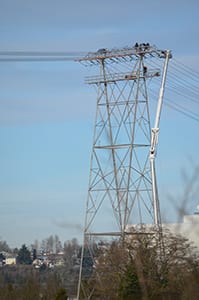
In the ongoing saga between ospreys and City Light infrastructure near the Duwamish River, the birds have been getting the upper talon.
That could change this spring. When the ospreys return to take advantage of the easy fishing and tall power line towers for nesting, they will find a new set of barriers designed to protect the power lines and keep the birds safe. They will also find new nesting platforms nearby, where they can raise their chicks in peace.
This March, City Light crews installed adjustable, triangular covers on top of the crossbeams of the electrical towers spanning the Duwamish River, near our substation. In between the covers, workers installed rods with loose plastic pipes that roll when birds try to perch on them. The barriers will hopefully prevent osprey from perching on the crossbeams and being able to wedge sticks and other nest building materials into the tower.
The lines and jumpers below have also been wrapped with insulating sleeves to prevent power outages when nest materials fall and make contact.
“We will be checking the Duwamish towers periodically this spring, to evaluate the effectiveness of the exclusion devices and will check the nesting platforms to see if the ospreys are being accommodated, which should reduce the risk of them nesting on City Light structures where they can cause outages or be injured or killed,” said City Light Wildlife Biologist Ron Tressler, who oversees the project.
“Hopefully the exclusion devices and platforms will result in osprey leaving our towers alone but if they don’t work, we’ll be back there again for another try,” he said.
City Light and NB Power in New Brunswick, Canada, are the only two utilities in the world using these experimental nesting deterrents. The devices were designed and fabricated by Jim Kaiser of Osprey Solutions, a specialist hired by City Light to help with some of the osprey issues.
The birds arrive here in spring to take advantage of the salmon released by the Icy Creek Pond hatchery upstream. In their natural habitat, ospreys prefer to build their nests on the top of large snags or deformed trees near water.
But the Duwamish waterway is an industrial corridor where the tallest bare structures are light poles, communications towers and other artificial structures. So those sites are being used by the increasing population of ospreys. Even thin light poles are suitable – ospreys can build a nest on as little as one square foot of space, according to Kaiser. There are approximately 12 nesting pairs in the lower Duwamish.
 The City Light towers on the Duwamish, besides serving as a tempting nesting surface, also carry several major electrical feeders that supply critical Boeing infrastructure. Over the years, ospreys have caused periodic outages, affecting Boeing’s operations.
The City Light towers on the Duwamish, besides serving as a tempting nesting surface, also carry several major electrical feeders that supply critical Boeing infrastructure. Over the years, ospreys have caused periodic outages, affecting Boeing’s operations.
In the past six years, osprey pairs have also nested on light poles at the Insurance Auto Auction lot on East Marginal Way, near the Duwamish River towers, and on a communications tower in the Sound Transit operations and maintenance facility near East Airport Way. Since the last nesting season, the company who owns the tower has installed exclusion devices to prevent osprey from nesting there in the future. Because these birds will return and likely try to find an alternate nest site on one of our nearby poles, City Light crews installed two new, safer platforms for the ospreys to nest and raise their young.
All of these efforts are part of City Light’s Avian Protection Program, which monitors incidents with birds and implements measures to keep the animals safe and the electrical equipment operating.